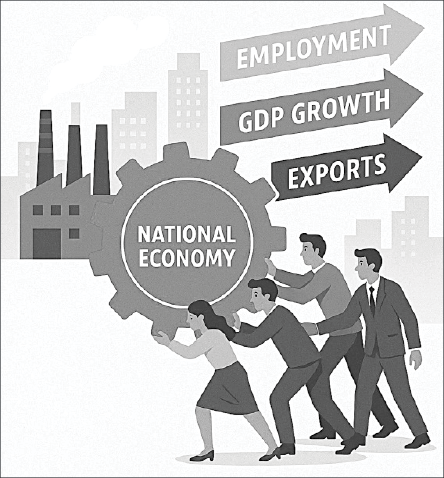
THE federal budget for 2025-26, passed recently with a substantial outlay of Rs17.573 trillion, regrettably lacks a dedicated development package for small and medium enterprises (SMEs). It fails to create the enabling policy environment necessary for their sustained growth. Although some allocations have been made under the Public Sector Development Programme (PSDP) for youth entrepre-
neurship and digital initiatives, a comprehensive financing framework or facilitation mechanism specifically tailored for the SMEs is noticeably absent.
Despite the introduction of various credit schemes by the State Bank of Pakistan (SBP), the monetary policy stance has not been supportive of SME financing. Even with a recent cut in the policy rate to 11 per cent — down from a peak of 22pc — the SMEs receive only 6-7pc of total private sector credit, far below the policy target of 17pc.
Furthermore, the liquidation of SME Bank, which was established to cater to this critical sector, has caused a significant institutional void.
Although the SBP has recently revised its regulations to encourage SME lending, much remains to be done as nearly half of all formal SMEs lack access to formal credit. Besides, the current tax regime continues to impose a disproportionate burden on small businesses. While digitisation has improved transparency in tax filing, the process remains complex and inaccessible to many SMEs, which often lack financial and digital literacy to ensure compliance. A simplified tax structure and meaningful relief for SME taxpayers should be a priority.
Technological backwardness also severely limits productivity among manufacturing SMEs. Most enterprises lack access to modern machinery, digital tools, and trained human capital.
Moreover, deficiencies in management practices, marketing strategies, and production processes further erode their competitiveness. Targeted initiatives by the government for technical upgradation, skills development, and market linkages are urgently needed to enable the SMEs to reach both domestic and international markets.
Additional structural challenges, such as high production costs, inadequate infrastructure, unreliable utility services, and restricted market access, also constrain SME development.
With the national population exceeding 241 million, strengthening SMEs is vital to tackling rising unemployment and poverty. Pakistan has over 5.2 million SMEs operating across both formal and informal sectors in manufacturing, trade and services. These businesses represent about 90pc of all private enterprises, employ nearly 80pc of the non-agricultural workforce, contribute roughly 40pc to the national gross domestic product (GDP), and account for about 25pc of total exports. Yet, they continue to face chronic challenges.
The National SME Policy 2021 had set ambitious goals with emphasis on regulatory reforms, industrial infrastructure development, entrepreneurship promotion, and improved access to finance. However, by mid-2025, progress has been limited, hindered by poor implementation, weak institutional coordination, and seriously insufficient political commitment. The recent budget has added to the problems.
Hussain Ahmad Siddiqui
Islamabad
Published in Dawn, August 4th, 2025







































